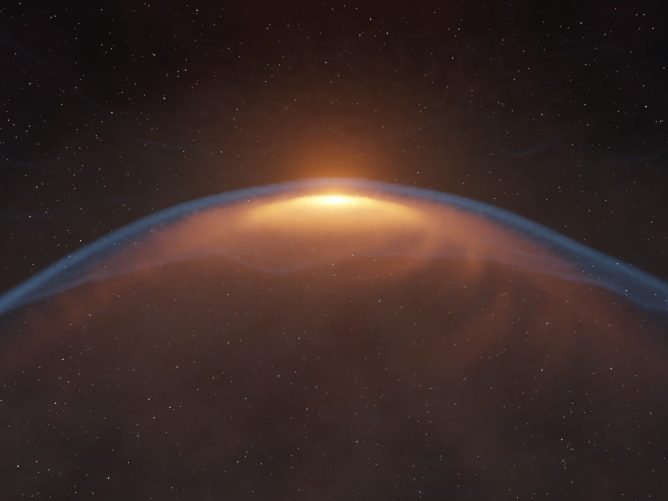Joint Press Release (2001 April 6)
-

- The above photograph shows how the ALMA facility may look like when it is ready at Chajnantor.
Representatives from Europe, Japan, and North America met in Tokyo today and signed a Resolution affirming their mutual intent to construct and operate a giant radio telescope in co-operation with the Republic of Chile, where the telescope will be located.
The Atacama Large Millimeter/Submillimeter Array (ALMA) has been conceived as a radio telescope comprised of sixty-four transportable 12-meter diameter antennas distributed over an area 14 km in extent. Japanese participation will allow enhanced imaging and spectroscopy, especially at submillimeter wavelengths. By pointing all the antennas in unison toward a single astronomical object, and combining the signals detected by all the antennas with a super-fast digital signal processor, this gigantic radio telescope achieves an imaging detail 10 times better than that of the Hubble Space Telescope. The combined area of all antennas used to collect signals from celestial objects is more than 40 times larger than that available to astronomers using existing submillimeter telescopes. ALMA will be built on the Andean plateau at 5,000 meters altitude near the Atacama Desert of northern Chile. This site provides the exceptionally dry atmospheric conditions necessary for astronomical observations at millimeter and submillimeter wavelengths (wavelengths between the radio and far-infrared spectral regions).
Observations with this telescope will have a profound impact on virtually all fields of astrophysical research. The most important targets include the most distant (i.e., the youngest) galaxies as they emerged in the early Universe. These are expected to have become rapidly enshrouded in the dust produced by the first stars; the dust absorbs much of the starlight making the galaxies difficult to see in the optical wavebands, but these same galaxies shine brightly at millimeter and submillimeter wavelengths. In our own Galaxy, ALMA will study the morphology, the motions and the chemistry of dust-enshrouded regions where stars and planets are being formed. ALMA will shed light on these optically `dark’ celestial regions that carry key information on the origin of the richness of structure in the Universe and clues to the origin of life.
ALMA is a merger of three large projects – The Millimeter Array (MMA) of the United States, the Large Southern Array (LSA) of Europe, and the Large Millimeter and Submillimeter Array (LMSA) of Japan – each of which has been endorsed as the top-priority project in their respective astronomical communities. The European and North American projects were merged into ALMA in 1999 and joint design and development of ALMA began at that time. The National Research Council of Canada is participating with the U.S. in the project. With Japan joining the project as a third partner equal with North America and Europe, and with Chile also taking part, ALMA has become one of the first truly global projects in the history of fundamental science.
In the agreement signed today, the partners pledge to use their best efforts to obtain full approval and funding for their participation in ALMA. With the schedule planned, the telescope should be in full operation in 2010.
- ※[1]: This Press Release is issued jointly by the European Southern Observatory (ESO) for its members plus UK and Spain, by the National Astronomical Observatory of Japan (NAOJ), by the US National Science Foundation (NSF) and by Comisión Nacional de Investigación Científica y Tecnológica (CONICYT) in Chile.









